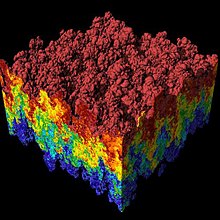計算物理学
| 計算物理学 |
|---|
 |
|
数値解析 · シミュレーション |
計算物理学(けいさんぶつりがく、英語: computational physics)は、解析的に解けない物理現象の基礎方程式を計算機(コンピュータ)を用いて数値的に解くことを目的とする物理学の一分野である。
概要
[編集]計算物理学では、ナヴィエ・ストークス方程式[1][2][3][4]やマクスウェル方程式[5][6][7]のような物理学での基礎方程式を計算機を用いてひたすら数値的に解く、という手法が用いられる。
流体力学でのナヴィエ・ストークス方程式やプラズマ物理学での磁気流体方程式のような微分方程式では、解析解が得られることはきわめてまれであり[8][9]、理論物理学では多くの場合断熱過程や線形性など近似を用いて物理現象を説明する。
ここ100年ほどの計算機とアルゴリズムの発達によって、大胆な近似を導入しなくても、「数値的に解く」ことで物理量のおおよその振る舞いを調べることが可能となった[10]。この計算機で得た数値的な解から新たな物理現象を発見することがこの分野の目的である。この数値的に解くことは一般には「シミュレーション」などと呼ばれる。
この分野は一般には、理論物理学に属すると考えることができるが、一方で、このような数値的な解析を「計算機実験」と称することもあるように、実験的な側面も存在する。このため、物理学における理論、実験以外の第三の分野として、この「計算物理学」を捉える考え方も存在する。たとえば、さまざまな条件下で基礎方程式を解くことで、新たな現象、効果の存在が示唆されることもあり、理論物理学者はそこから理論モデルを構築する。一方で大規模な実験の前にはほとんど必ずシミュレーションが行われており、実験を行う根拠として数値解析の結果が使われる。
脚注
[編集]- ^ Temam, R. (2001). Navier-Stokes equations: theory and numerical analysis (Vol. 343). American Mathematical Soc..
- ^ Marion, M., & Temam, R. (1998). Navier-Stokes equations: Theory and approximation. Handbook of numerical analysis, 6, 503-689.
- ^ Girault, V., & Raviart, P. A. (2012). Finite element methods for Navier-Stokes equations: theory and algorithms (Vol. 5). Springer Science & Business Media.
- ^ Moser, R. D., Moin, P., & Leonard, A. (1983). A spectral numerical method for the Navier-Stokes equations with applications to Taylor-Couette flow. Journal of Computational Physics, 52(3), 524-544.
- ^ Monk, P. (2003). Finite element methods for Maxwell's equations. Oxford University Press.
- ^ Makridakis, C. G., & Monk, P. (1995). Time-discrete finite element schemes for Maxwell's equations. ESAIM: Mathematical Modelling and Numerical Analysis, 29(2), 171-197.
- ^ Cockburn, B., Li, F., & Shu, C. W. (2004). Locally divergence-free discontinuous Galerkin methods for the Maxwell equations. Journal of Computational Physics, 194(2), 588-610.
- ^ Constantin, P., & Foias, C. (1988). Navier-stokes equations. University of Chicago Press.
- ^ Foias, C., Manley, O., Rosa, R., & Temam, R. (2001). Navier-Stokes equations and turbulence (Vol. 83). Cambridge University Press.
- ^ Brezinski, C., & Wuytack, L. (2012). Numerical analysis: Historical developments in the 20th century. Elsevier.
参考文献
[編集]- 夏目雄平、小川建吾、鈴木敏彦、計算物理 (全三巻)、朝倉書店。
- Thijssen, Jos (2007). Computational Physics. en:Cambridge University Press. ISBN 978-0521833462.
- Landau, Rubin H.; Páez, Manuel J.; Bordeianu, Cristian C. (2015). Computational Physics: Problem Solving with Python. John Wiley & Sons.
- Landau, Rubin H.; Paez, Jose; Bordeianu, Cristian C. (2011). A survey of computational physics: introductory computational science. en:Princeton University Press.
- Steven E. Koonin, Computational Physics, en:Addison-Wesley (1986)
- T. Pang, An Introduction to Computational Physics, en:Cambridge University Press (2010)
- B. Stickler, E. Schachinger, Basic concepts in computational physics, en:Springer Verlag (2013). ISBN 9783319024349.
- 計算物理 春の学校 2023 (YouTube Channel)
関連記事
[編集]物理学の分野 | |
|---|---|
| 古典・量子 | |
| 研究方法 | |
| 基礎理論 | |
| 研究対象 | |
| 境界領域 | |
| その他 | |
Text is available under the CC BY-SA 4.0 license; additional terms may apply.
Images, videos and audio are available under their respective licenses.
